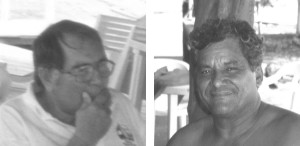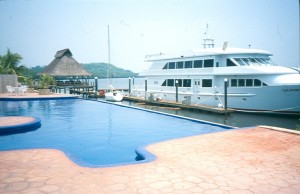By Martin Mowforth
The Santa Marta Five – Teodoro Antonio Pacheco, Saúl Agustín Rivas Ortega, Miguel Ángel Gámez, Alejandro Laínez García, and Pedro Antonio Rivas Laínez – were arrested in January 2023 for ‘illicit association’ and an alleged murder that took place over 34 years ago during the Salvadoran war in the 1980s.
As members of ADES (Association for the Economic Development of El Salvador), the five activists are referred to as ‘water defenders’ on account of their activism in the National Water Forum and the National Alliance Against the Privatisation of Water. But their significance from the point of view of the government of President Nayib Bukele is that the five water defenders were also crucial activists in the campaign of the National Roundtable Against Metallic Mining that resulted in the 2017 ban on metal mining in El Salvador, the first country in the world to implement such a ban.
That campaign had been led by ADES in collaboration with a number of other NGOs in El Salvador and had gained a remarkable level of public support that led all the major political parties to back the policy of a ban on metal mining. It now seems highly likely that the current Salvadoran government is attempting to row back against the mining ban and to invite international mining companies to invest in the country again.
The campaign to ban metal mining was motivated by concerns about the effects on the water table of gold exploration and exploitation. In the department of Cabañas where the Canadian mining company Pacific Rim had begun to explore for the metal, even exploration had given rise to a lowering of the water table and its contamination. There were social impacts too, especially in the form of assassinations of anti-mining activists – see this website: https://theviolenceofdevelopment.com/assassinations-and-other-human-rights-violations-of-anti-mining-activists/ .
The Five were instrumental in the campaign that led to the 2017 mining ban. Their detention is believed by many to be politically motivated, especially given the lack of evidence presented by the Attorney General’s office to warrant the charges and the loss of due process under El Salvador’s current ‘state of exception’, an emergency measure brought in by President Bukele to combat the growing violence associated with the gang culture in the country. The state of exception has now been in force for over two years, Bukele’s 25 monthly requests since its inception having been granted by legislators every time.
After several months in detention following their arrest, in August 2023 they were released into house arrest, but now await a trial which a preliminary court hearing in April this year determined they should stand despite a lack of evidence against them. The charges they face are widely seen as a SLAPP – a Strategic Lawsuit Against Public Participation – see this website: https://theviolenceofdevelopment.com/slapps-strategic-lawsuits-against-public-participation/
Salvadoran and international non-governmental organisations (NGOs) have campaigned and continue to campaign on behalf of the Five, demanding that the charges be dropped. Groups involved in the campaign include NGOs from Germany, Honduras, Canada, the United States and various Latin American groups. The UN Special Rapporteur on Human Rights Defenders is monitoring the case, and this general high international interest and pressure could be significant.
International Allies has coordinated the campaign involving academics, lawyers and many international groups, all critical of the lack of evidence behind the charges. John Cavanagh, a Senior Advisor at the Institute for Policy Studies in the USA, said:
It is outrageous that the judge is allowing this trial to go forward despite the lack of any evidence of a crime. The international community stands strong with the five leaders of the successful fight against mining, and we will join Salvadoran water defenders to continue to fight with them for justice in this case.
The international attention generated by the end of April 2024 has been essential to ensure that the Five gain the right to due process (based on international standards), and will remain essential as the trial moves to court.
Sources
- International Allies, 4 April 2024, ‘The fate of the Santa Marta Water Defenders is now in the hands of a judge’, International Allies Against Mining in El Salvador, San Salvador.
- Alexis Stoumbelis, 16 April 2024, CISPES Action Alert, Committee in Solidarity with the People of El Salvador (CISPES), Washington DC.
- Giada Ferrucci and Pedro Cabezas, 19 April 2024, ‘Solidarity with El Salvador’s Santa Marta 5 Grows Across Borders’, NACLA (North American Congress on Latin America), New York.
- CISPES, 28 March 2022, ‘The Privatisation of Water in El Salvador’, accessible in The Violence of Development website at: theviolenceofdevelopment.com.the-privatization-of-water-in-el-salvador/
- International Allies, 10 April 2024, ‘International Community Condemns April 10 Ruling in El Salvador’s Court on the Santa Marta Five Water Defenders’, International Allies Against Mining in El Salvador, San Salvador.
- The Violence of Development website, https://theviolenceofdevelopment.com/assassinations-and-other-human-rights-violations-of-anti-mining-activists/
- The Violence of Development website, https://theviolenceofdevelopment.com/slapps-strategic-lawsuits-against-public-participation/

 d around the community, residents report that Sr. Membreño’s supposed benevolence towards the local community has concealed his aggressive approach to acquiring the land required for the development. The family of Max Garay is one of the few Nicaraguans families in Aserradores who owned sizeable parcels of land. He explains:
d around the community, residents report that Sr. Membreño’s supposed benevolence towards the local community has concealed his aggressive approach to acquiring the land required for the development. The family of Max Garay is one of the few Nicaraguans families in Aserradores who owned sizeable parcels of land. He explains: